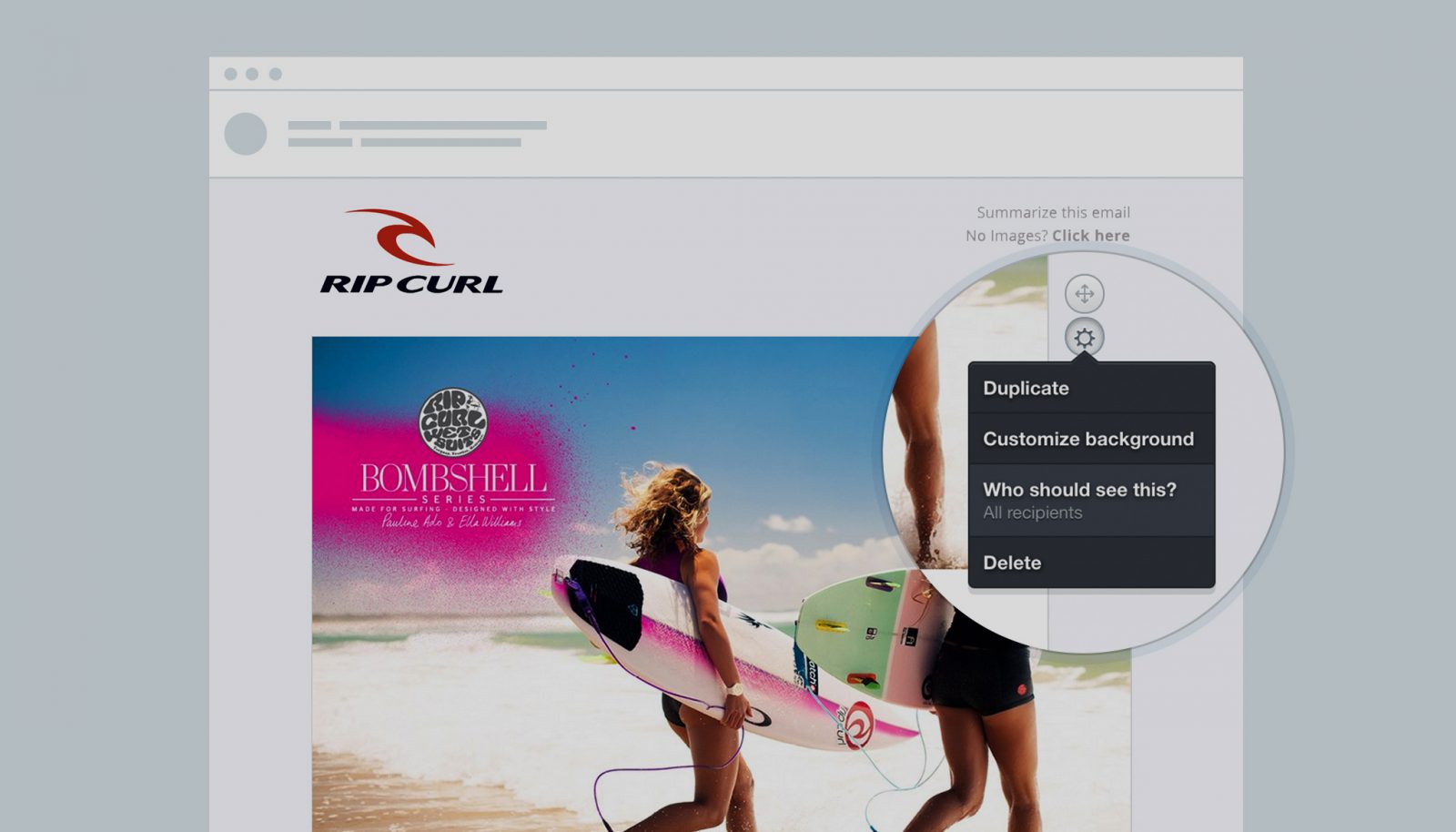We do a lot of email marketing here at Campaign Monitor.
In the content team alone, we send over 250,000 emails per month across 15 different campaigns. And that’s just our team.
We’re big fans of A/B testing and are constantly striving to get better results from our campaigns. So when we noticed that our newsletter click-through rates were plateauing, we decided to run a few tests to see if we could boost them up.
With the addition of dynamic content to our email builder, we decided to see if we could use it to increase conversions on a campaign.
In this post, we’ll outline what dynamic content is, how it got us a 13% increase in conversions, and how you can put it to use in your own campaigns to improve your results.
What is dynamic content?
Dynamic content is a feature in certain email marketing tools (Campaign Monitor included) that enables you to display different content in your email campaigns to different recipients, based on what you know about them.
Common use cases include:
- Showing men’s clothing to males and women’s clothing to females, in your campaign about the latest winter fashion to hit your store.
- Showing a 20% discount offer to your best customers, and a 10% discount offer to others, in a campaign announcing your latest sale.
It’s kind of similar to personalization, but on a bigger scale. While personalization tags allow you to dynamically insert text values into your emails (like someone’s first name for instance), dynamic content can actually change entire sections of content based on the details of individual recipients.
You can show an entire section of content, including text, images, and buttons, to some subscribers (e.g. males or top spending customers) while showing a different section of content to other subscribers (e.g. females or lower spending customers).
It’s a great way to make sure the campaigns you’re sending are super relevant to every recipient. This tool also helps you get higher click-throughs and sales from your email campaigns.
How we used dynamic content to get a 13% increase in conversions.
We launched a guide on Internationalizing Your Email Campaigns, covering everything from translating your copy to using culturally-sensitive images. Shortly after, we’d been thinking about running some tests on our monthly newsletter to improve its performance. One of our designers came up with the idea of using dynamic content to change the image we use in the newsletter to promote the guide.
So we used the geolocation feature to split our newsletter list into multiple segments based on the subscriber’s location, and then created a number of different graphics for the most popular countries.

With the images completed and our newsletter list segmented by country, we loaded the content into the email builder and used the dynamic content feature to show the different images to people in their respective countries.
We also set the whole campaign up as an A/B test so that one version went out with the dynamically changing content, and one version went out with a generic image. This allowed us to compare the click-through rate of the version with dynamic content to the version without it, and see whether it improved conversions or not.
The result? By creating imagery that specifically appealed to each individual recipient of the email we were able to get a 13% increase in conversions and drive thousands of extra visitors to the guide.
5 steps to using dynamic content in your own campaigns.
To help you add dynamic content and increase your conversions, we’ve broken the process down into five simple steps you can follow.
Step 1: Develop a hypothesis for how dynamic content will improve conversions.
To be perfectly honest, the test we ran could have gone either way. While it ended up increasing conversions for us, changing the icon was a little bit of a novelty, and it only minorly improved the relevance of the email to the individual recipient.
In order to have the highest chance of getting a positive increase in conversions from using dynamic content, the elements you change should significantly improve the relevance of the content the recipient receives.
So to get started, come up with a basic hypothesis in your head. It could be as simple as “We believe showing men’s clothing to males and women’s clothing to females will make the content more relevant to the recipient and increase click-through rate.”
That simple statement, even if just said in your mind, helps you define what content you are going to dynamically change and what you hope to achieve by doing so. This helps keep your use of dynamic content focused on improving results.
Step 2: Create your content.
Once you have your hypothesis in mind, and you know what you want to change, it’s time to create the content for the different sections.
In our case, we created different variations of the internationalization illustration for each country segment we were targeting, but the content you create really depends on what you’re changing.
If you’re showing men’s clothing versus women’s clothing, then create the content for both of those sections. If, on the other hand, you’re showing a 20% discount versus a 10% discount, then you’ll need to create both graphics to be used in your campaign.
Step 3: Load it all into the email builder.
This step is going to make your email look pretty interesting, but bear with me here.
Dynamic content works on a “show or doesn’t show” logic. You enter all your content into the email and then select which segments of your list should see this particular section and which segments should not.
So when you create your email campaign in the builder, it actually looks a bit like this:
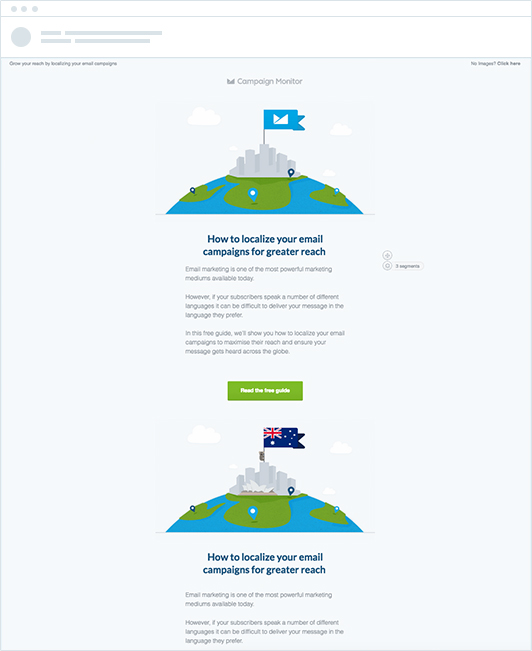
As you can see, the email looks pretty intense in the builder because every piece of content is showing. However, once you’ve gone through and selected which sections show for which segment of people (the next step), it all works itself out, and your email comes out looking like this:
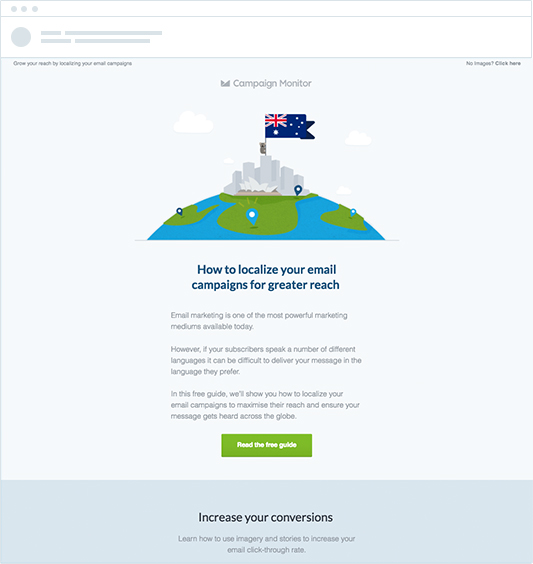
Step 4: Set targeting options for each section.
Now that you have all your content in the email builder, it’s time to set the targeting options for each content section to ensure the right people see the right content.
Considering this is quite advanced email marketing, it’s actually very easy to do. You simply select the settings icon next to the content section you want to make dynamic, then select the segment of your list who should see this content.
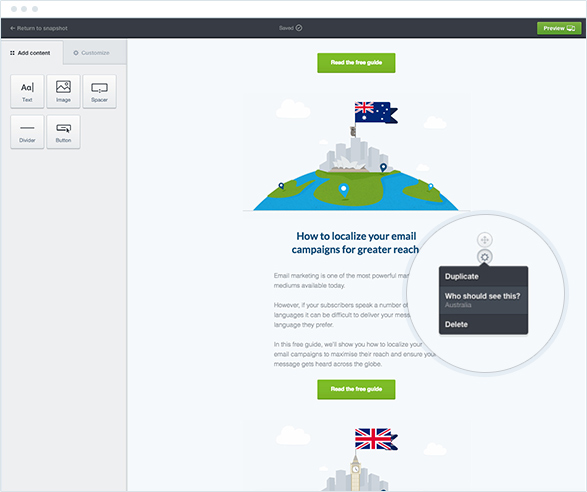
This tells the email builder that this section should be included in the email that goes out to this segment of your list.
Step 5 (optional): Set it up as an A/B test.
If you’re interested in testing whether using dynamic content increases conversions for you, then you can set up the campaign as an A/B test and compare the results of the version with dynamic content to the version without.
The good thing about A/B testing emails in email tools like Campaign Monitor is that it’s super easy.
You simply select the A/B test option from the Create Campaign screen, create your two email versions (one with dynamic content and one without), choose the test length, and away you go.
Campaign Monitor will then send the two versions to a portion of your list, and whichever performs best after the timeframe you set will be automatically sent to the rest of your subscribers.
You also get great reports (like the one below) which shows you how each one performed.
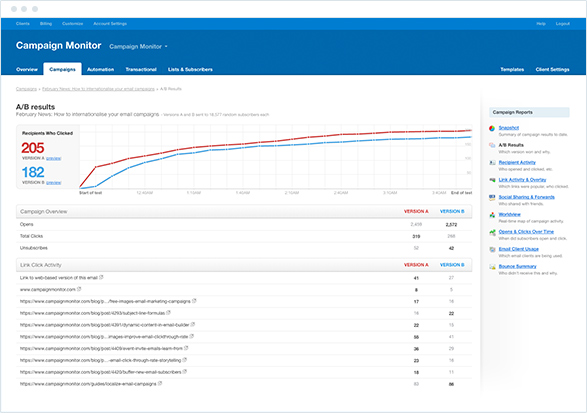
Wrap up.
If your email click-through rates are plateauing like ours were, one of the best ways to improve them is by increasing the relevance of your email campaigns to each individual subscriber.
While there are various ways you can do that, using dynamic content in your campaigns is one of the quickest and easiest ways to get an instant boost in your click-through rates.
So give it a try today and let us know how you go!
